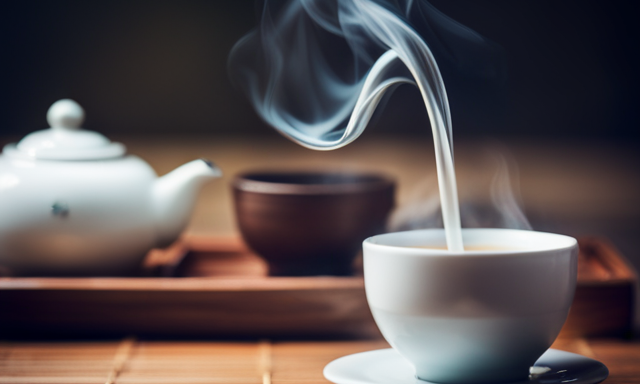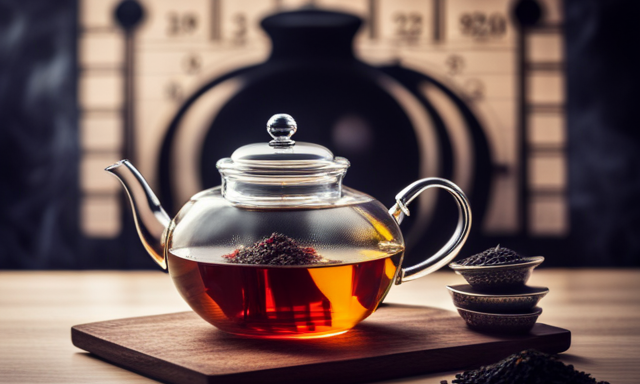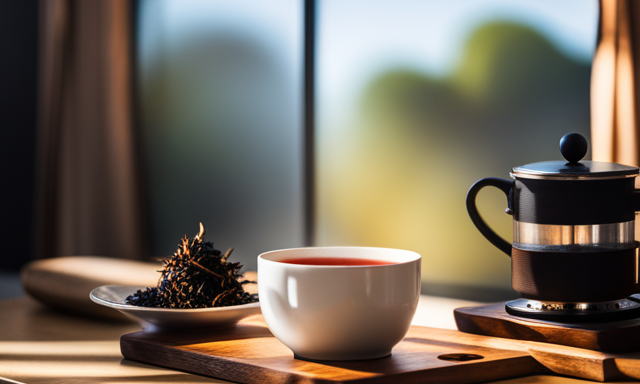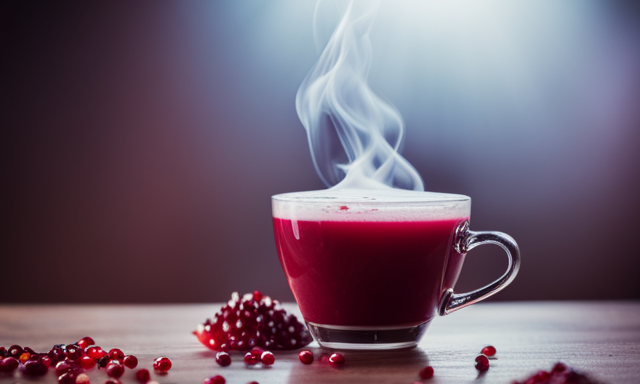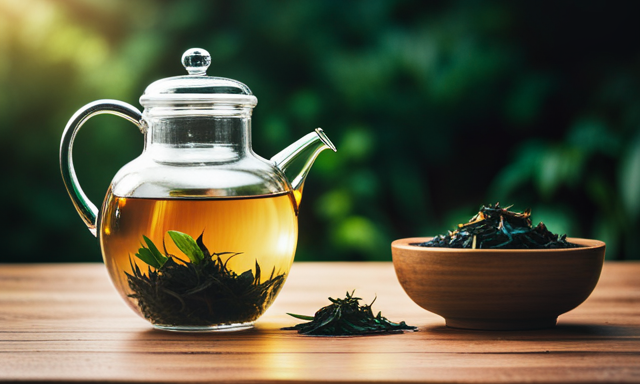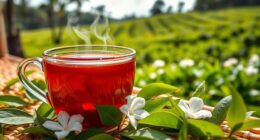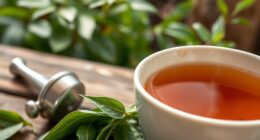Are you a tea lover like me? Are you ready to embark on a flavorful journey to discover the art of making oolong tea? Well, you’re in the right place!
In this article, I will guide you through the steps to properly make oolong tea, from understanding the different types of oolong tea to exploring its health benefits.
As an avid tea enthusiast, I have spent years perfecting my oolong tea brewing technique, and now I’m thrilled to share my knowledge with you. Whether you’re a beginner or an experienced tea drinker, this article will provide you with all the information you need to brew a delicious and authentic cup of oolong tea.
So, grab your teapot and get ready to awaken your senses with the aromatic and complex flavors of oolong tea. Let’s dive into the world of oolong tea together!
Key Takeaways
- Oolong tea comes in various flavors and characteristics, such as floral, fruity, and toasty.
- Choose tightly rolled tea leaves for higher quality.
- Use porcelain or clay teapots for better heat retention.
- Water temperature and steeping time should be balanced for the best flavor extraction.
Understanding the Different Types of Oolong Tea
Now let’s dive into the world of oolong tea and discover the various types that will leave you craving for more! Oolong tea comes in a range of different flavors, each with its own distinct characteristics. From the floral and fruity notes of Tie Guan Yin to the rich and roasted flavors of Da Hong Pao, there is an oolong tea for every palate.
These different flavors are a result of the unique processing methods used for each type of oolong tea. Oolong tea has its origins in China and Taiwan, where it has been cultivated for centuries. The climate, soil conditions, and traditional production techniques all contribute to the distinct flavors and aromas of oolong tea.
Now, let’s move on to the next section and explore the art of selecting high-quality oolong tea leaves.
Selecting High-Quality Oolong Tea Leaves
To ensure you’re sipping the cream of the crop, dive into the world of oolong tea by carefully selecting tea leaves that are a cut above the rest. When choosing oolong tea, it’s important to consider the quality and origin of the leaves. Look for tea leaves that are tightly rolled, as this indicates a higher grade. Additionally, consider the flavor profile you prefer – whether it’s floral, fruity, or toasty. To assist you in your selection, refer to the table below:
| Type of Oolong Tea | Flavor Profile | Origin |
|---|---|---|
| Tie Guan Yin | Floral | China |
| Da Hong Pao | Toasty | China |
| Oriental Beauty | Fruity | Taiwan |
By carefully choosing oolong tea that suits your taste preferences and knowing the benefits of oolong tea, you can elevate your tea-drinking experience. Now, let’s move on to preparing your teapot and tea leaves.
Preparing Your Teapot and Tea Leaves
Get ready to enhance your tea-drinking experience by preparing your teapot and tea leaves like a pro. To start, choose a teapot that is made of porcelain or clay, as these materials can retain heat and enhance the flavor of oolong tea.
Additionally, consider the size of the teapot based on the number of cups you plan to serve.
Next, measure the tea leaves accurately. Use approximately one teaspoon of tea leaves per cup of water for a rich and flavorful brew. Remember, the quality of your oolong tea greatly depends on the proper ratio of tea leaves to water.
Now, you’re ready to move on to the next step – achieving the perfect water temperature and steeping time for your oolong tea.
Proper Water Temperature and Steeping Time
Achieving the perfect water temperature and steeping time is crucial for extracting the full flavor and aroma from your oolong tea. Finding the perfect balance between water temperature and steeping time is essential to unlock the delicate nuances of oolong tea. Too hot of water can scorch the leaves, resulting in a bitter taste, while water that’s too cool won’t fully extract the tea’s flavors. Similarly, steeping for too long can make the tea taste overly strong and astringent, while steeping for too short a time may result in a weak and bland cup. To guide you, here’s a table that illustrates the recommended water temperature and steeping time for oolong tea:
| Water Temperature | Steeping Time |
|---|---|
| 185°F (85°C) | 3-5 minutes |
| 195°F (90°C) | 2-3 minutes |
| 205°F (96°C) | 1-2 minutes |
| 212°F (100°C) | 30-60 seconds |
| 212°F (100°C) | Multiple short steeps |
Mastering the art of tea brewing involves not only understanding the proper infusion time and temperature but also appreciating the rich history and cultural significance behind this ancient beverage.
Mastering the Art of Tea Brewing
Brewing the perfect cup of tea is like conducting a symphony of flavors, where each element harmonizes to create a delightful sensory experience. To master the art of tea brewing, it is essential to understand the different tea brewing techniques and have the right tea brewing equipment. Here are three key elements to consider:
-
Water temperature: Different tea varieties require specific water temperatures to bring out their best flavors. Green oolong tea, for example, is best brewed at around 175°F (80°C), while darker oolongs can handle higher temperatures of around 195°F (90°C).
-
Steeping time: The steeping time varies depending on the type of oolong tea and personal preference. Lighter oolongs generally require shorter steeping times of 1-2 minutes, while darker oolongs may need 3-4 minutes to fully develop their flavors.
-
Tea brewing equipment: Invest in a good quality tea kettle or electric kettle with temperature control, a tea infuser or teapot with a built-in strainer, and a timer to ensure precision in brewing.
By mastering these tea brewing techniques and using the right tea brewing equipment, you can elevate your oolong tea experience to new heights.
Now, let’s explore how to enhance the flavor with tea accessories.
Enhancing the Flavor with Tea Accessories
Tea accessories can take your tea experience to a whole new level by adding a touch of elegance and enhancing the flavors. When it comes to oolong tea, there are various tea brewing techniques and tea infusion methods that can be enhanced with the right accessories.
For example, a tea infuser can help you achieve the perfect infusion by allowing the tea leaves to expand and release their flavors. A tea timer can ensure that you steep your oolong tea for just the right amount of time, resulting in a balanced and flavorful cup. Additionally, a tea kettle with a built-in temperature control can help you achieve the optimal water temperature for brewing oolong tea.
With these accessories, you can elevate your oolong tea brewing experience.
Now, let’s move on to the next step of decanting and serving oolong tea.
Decanting and Serving Oolong Tea
After enhancing the flavor of oolong tea with tea accessories, it’s time to move on to the next step: decanting and serving the tea.
Decanting techniques can make a significant difference in the taste and aroma of your oolong tea. When decanting, it’s essential to pour the tea slowly and gently to avoid disturbing the leaves and potentially affecting the flavor.
It’s recommended to use a glass or porcelain teapot with a fine mesh strainer to strain the leaves while pouring. This ensures a smooth and enjoyable tea-drinking experience.
When serving oolong tea, consider using small teacups to fully appreciate its complex flavors. You can also experiment with different serving temperatures, as oolong tea can be enjoyed hot or cold.
Now that we’ve mastered decanting and serving techniques, let’s move on to the exciting world of pairing oolong tea with food.
Pairing Oolong Tea with Food
To fully appreciate the rich flavors of oolong, one must explore the art of pairing this exquisite beverage with a wide array of culinary delights. When it comes to tea pairing, there are endless flavor combinations to explore. Here are a few suggestions to enhance your oolong tea experience:
-
Delicate floral oolongs, such as Tie Guan Yin, pair well with light and refreshing dishes like salads or steamed fish.
-
Roasted oolongs, like Da Hong Pao, are a perfect match for savory dishes like roasted meats or stir-fried vegetables.
-
Fruity oolongs, such as Oriental Beauty, can be paired with desserts like fruit tarts or chocolate.
-
For a unique twist, try pairing heavily oxidized oolongs, like Wuyi Rock Tea, with spicy foods to create a harmonious contrast.
Now that you know how to pair oolong tea with food, let’s move on to storing oolong tea for optimal freshness.
Storing Oolong Tea for Optimal Freshness
When it comes to enjoying oolong tea, proper storage is essential to preserve its freshness and flavor. Storing oolong tea correctly ensures that you can enjoy its delightful taste for a longer period of time. To keep your oolong tea at its best, store it in an airtight container away from light, moisture, and strong odors. This will help to prevent exposure to elements that can degrade its quality. Additionally, it is important to keep your oolong tea away from spices, as it can absorb their aromas and flavors. By following these simple steps, you can maintain the optimal freshness of your oolong tea and truly savor its delicate notes. Now, let’s explore the health benefits of oolong tea and how it can enhance your well-being.
Exploring the Health Benefits of Oolong Tea
Exploring the health benefits of oolong tea reveals its remarkable ability to enhance overall well-being.
Oolong tea has a rich history that dates back centuries, originating in China and becoming popular worldwide. Its cultural significance is evident as it is often used in traditional Chinese ceremonies and is regarded as a symbol of hospitality and friendship.
But beyond its cultural importance, oolong tea offers numerous health benefits. Packed with antioxidants, it helps to boost the immune system and fight against free radicals.
Oolong tea also aids in weight management by increasing metabolism and promoting fat oxidation. Additionally, it supports heart health by reducing cholesterol levels and improving cardiovascular function.
With its fascinating history and incredible health benefits, oolong tea truly deserves its place as a beloved beverage across cultures.
Frequently Asked Questions
Can I use oolong tea bags instead of loose tea leaves?
Using oolong tea bags instead of loose tea leaves has its pros and cons. Tea bags offer convenience, but loose leaves provide a better flavor. The taste of oolong tea is more robust and nuanced when brewed using loose tea leaves.
What is the ideal brewing time for oolong tea?
The ideal brewing time for oolong tea is 3-5 minutes. Steep it at the ideal steeping temperature of 190-200°F to bring out its full flavor and enjoy the numerous health benefits it offers.
Can I reuse oolong tea leaves for a second steeping?
Yes, you can reuse oolong tea leaves for a second steeping. The benefits of a second steeping include a milder flavor and lower caffeine content. It’s a great way to make the most of your tea leaves.
How should I clean my teapot after brewing oolong tea?
To clean my teapot after brewing oolong tea, I use gentle cleaning techniques. I find that a mixture of warm water and mild dish soap works well. For stubborn stains, a solution of vinegar and water can be effective.
Is it necessary to decant oolong tea before serving?
Decanting oolong tea before serving has its benefits. It allows the flavors to fully develop and enhances the taste. By separating the leaves from the liquid, you can ensure a smooth and balanced flavor profile.
Conclusion
In conclusion, making oolong tea is a delightful and rewarding experience. By understanding the different types of oolong tea and selecting high-quality leaves, you can ensure a delicious brew.
Preparing your teapot and using the proper water temperature and steeping time are key to unlocking the full flavor of oolong tea.
Mastering the art of tea brewing will elevate your tea-drinking experience to new heights. And don’t forget to decant and serve your tea with style!
Finally, pair oolong tea with food and store it properly to maintain its optimal freshness. With its numerous health benefits, oolong tea is truly a remarkable beverage.
So go ahead, indulge in a cup of this exquisite tea and let its rich aroma and smooth taste transport you to a world of pure bliss!

